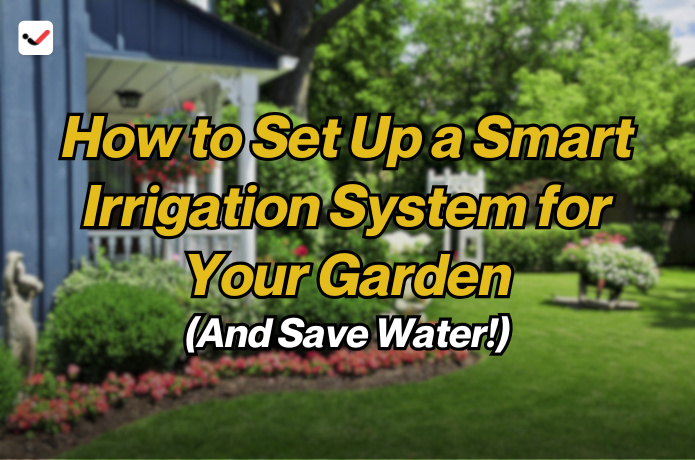How to Set Up a Smart Irrigation System for Your Garden (And Save Water!)
How to Set Up a Smart Irrigation System for Your Garden (And Save Water!)

Maintaining a healthy garden while saving water is now easier than ever, thanks to a smart irrigation system. These systems use weather data, moisture sensors, and smart controllers to water your plants only when needed. That means no more guesswork, no wasted water, and a greener lawn or more vibrant flower beds—without lifting a finger.
Not only can a smart irrigation system cut your water bill by up to 50%, but it also helps plants grow stronger by giving them the right amount of water at the right time. In this guide, we’ll walk through setting up a smart irrigation system step by step, so you can enjoy an efficient garden that thrives while conserving water.
1. Plan Your Garden Zones
Every garden is unique, and your driveway or vegetable bed won’t all need the same water. Start by sketching your garden layout and dividing it into zones—like lawn, flowers, shrubs, or herbs. Group plants with similar watering needs together to create consistent zones. This way, your smart sprinkler system or drip irrigation will target each zone precisely.
Many smart irrigation controllers allow multiple zones, so you can set different watering amounts or times depending on plant needs and soil type.
2. Choose the Right System: Drip vs. Sprinkler
Two common types of smart irrigation systems are drip irrigation and smart sprinkler systems.
Drip irrigation delivers water slowly and directly to plant roots. It minimizes evaporation and runoff, using up to 50% less water compared to sprinklers.
Smart sprinkler systems work well for lawns and larger areas. When paired with weather-based controllers, they adjust watering schedules automatically, skipping cycles when it rains.
If your garden has flower beds, trees, or containers, drip irrigation is ideal. For lawns and larger open spaces, a smart sprinkler system with weather controls works well.
3. Gather the Necessary Equipment
Here’s what you’ll need to get started:
- Smart controller (Wi‑Fi enabled, app‑controlled)
- Soil moisture sensors or weather sensors
- Drip tubing or sprinkler heads
- Solenoid valves (automate water flow)
- Filter and pressure regulator (to protect your system)
- Pipes and fittings to run water to each zone
Smart controllers use real-time weather data and soil moisture sensor readings to optimize watering cycles. Installing a filter and pressure regulator ensures consistent water pressure, protecting tubes and emitters.
4. Install Tubing, Valves, and Sensors
1. Lay out tubing along each zone. For drip systems, use a flexible drip tube with emitters. For sprinklers, mark where the heads will go.
2. Connect solenoid valves to each zone. These valves turn water on/off based on signals from the smart controller. Use a filter before valves to prevent clogs.
3. Mount moisture or rain sensors near plant roots or exposed to rainfall. Sensor data helps prevent overwatering, skipping cycles after rain.
4. Link everything to the smart controller, using wires to connect valves and sensors. Most controllers support Wi‑Fi and offer an app for remote control.
5. Set Up and Configure the Controller
Once installed, set your smart controller:
- Define zones and the number of connected valves
- Input your soil type, plant types, and sun exposure
- Connect to Wi‑Fi and allow the system to gather local weather data
- Place moisture sensors in the root zone for irrigation feedback.
Controllers use weather-based algorithms—also called earth‑moisture or ET data—to adjust watering times automatically, saving water and avoiding overwatering.
6. Set Realistic Watering Schedules
When setting schedules:
- Water early morning or late evening to reduce evaporation
- Deep, infrequent watering encourages strong root systems
- Let smart weather tracking skip cycles automatically after rain
- For drip systems, aim for slow, steady watering directly to the soil
7. Monitor, Adjust, and Maintain
A smart irrigation system isn’t set‑and‑forget. Follow these steps:
- Check the app regularly. Many controllers send alerts if a valve fails or there’s a leak
- Inspect sensors twice a season—soil moisture sensors need to stay clean and at the right depth
- Flush tubing or clean filters monthly to prevent clogs
- Adjust schedules by season—reduce watering during rainy periods or winter
8. Enjoy Water Savings and Healthier Plants
By using a smart irrigation controller with soil moisture or weather sensors, gardens typically see water savings of 30‑60% compared to manual or mechanical timers. Savings depend on your climate, plants, and setup, but many homeowners report cutting water bills nearly in half within one year.
Beyond cost savings, precise irrigation promotes deeper root systems, healthier soil, and stronger plants. Smart irrigation systems also reduce runoff, prevent fungal disease, and follow local water regulations more effectively.

